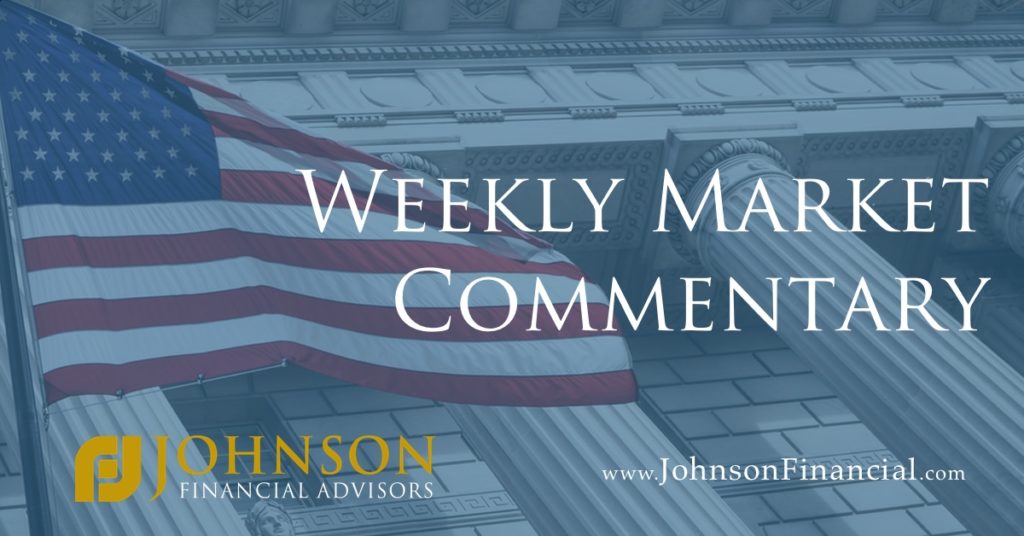
Weekly Market Commentary – 01/08/2018
The Markets
The three major indexes posted record gains Friday. Following the Monday holiday, the three benchmarks enjoyed their strongest first four trading days of a year for more than a decade. For the week, the Dow rose 2.37 percent to close at 25,295.87. The S&P gained 2.63 percent to finish at 2,743.15, and the NASDAQ climbed 3.38 percent to end the week at 7,136.56.
- The trade deficit in goods and services came in at $50.5 BN
- Exports rose $4.4 BN led by civilian aircraft, petroleum products, and autos
- Imports rose by $6 BN led by crude oil, cell phones and other household goods, and
- The ISM Non-Manufacturing index declined to 55.9 in December from 57.4 in November stil
- The ISM Manufacturing index rose to 59.7 in December from 58.2 in November still signalin
- The labor market remains healthy:
- The unemployment rate remained at 4.1%
- Average hourly earnings (wage growth) are up 2.5% versus a year ago as of Decembe
- Nonfarm payrolls rose 148,000 in December
- The probability of a rate hike for the March 2018 Fed Meeting is currently around 75%
| Returns Through 1/05/18 | 1 Week | YTD | 1 Year | 3 Year | 5 Year |
| Dow Jones Industrials (TR) | 2.37 | 2.37 | 30.19 | 15.95 | 16.32 |
| NASDAQ Composite (PR) | 3.38 | 3.38 | 30.04 | 15.33 | 18.14 |
| S&P 500 (TR) | 2.63 | 2.63 | 23.34 | 13.08 | 15.74 |
| Barclays US Agg Bond (TR) | -0.32 | -0.32 | 2.75 | 1.94 | 2.12 |
| MSCI EAFE (TR) | 2.45 | 2.45 | 25.28 | 9.67 | 8.03 |
Shift in Type — In 1975, defined contribution plans outnumbered defined benefit plans two to one, i.e., 207,700 to 103,300. Forty years later in 2015, defined contribution plans outnumbered defined benefit plans 14 to one, i.e., 648,300 to 45,600 (source: Government Accountability Office, BTN Research).
For the Entire Year — The S&P 500 was positive on a total return basis during all 12 months in calendar year 2017, gaining 21.8 percent for the year. The raw index rose 19.4 percent, and the impact of reinvested dividends made up the difference (source: BTN Research).
Foreign Stocks — The international stock index EAFE gained 25 percent (total return) in 2017. EAFE is an unmanaged index generally considered representative of the international stock market. These international securities involve additional risks including currency fluctuations, differing financial accounting standards and possible political and economic volatility (source: BTN Research).
WEEKLY FOCUS – Tax Cuts and Jobs Act Changes
Last month, President Trump signed the first major tax overhaul since Ronald Reagan was in office. The Congressional Budget Office forecasts the 500-page legislation will add $1.5 trillion to the national debt over the next decade. With sweeping changes come questions and concerns. Below is an overview of the major changes you will encounter when filing taxes for 2018.
- The 10 and 35 percent tax brackets remain the same, while the 15 percent bracket drops to 12 percent, the 25 to 22, the 28 to 24, the 33 to 32 and the 39.6 to 37. Income thresholds for the tax brackets above the new 22 percent bracket are raised. However, all individual tax cuts are scheduled to go away after 2025.
- The standard deduction almost doubles, increasing to $12,000 for individuals and $24,000 for married couples. This will lead less people to itemize their taxes.
- The personal exemption is eliminated.
- The state and local tax deduction now has a cap of $10,000.
- The threshold for estate taxes is doubled. Individuals can bequeath up to $11 million tax-free ($22 million for married couples) in 2018.
- The child tax credit doubles to $2,000 for children under 17, and its income threshold was raised so more parents can claim the entire credit. There’s also a new $500 credit for non-child dependents, like elderly parents.
- The mortgage interest deduction decreases from $1 million to $750,000.
- Up to $10,000 a year per student can be used out of a 529 education savings account on primary and secondary education costs. Before, they could only be used for post-secondary education.
Other big changes: The corporate tax rate is now 21 percent, down from 35 percent, the largest corporate tax cut in U.S. history. The corporate alternative minimum tax (AMT) is removed, and fewer people will have to pay the individual AMT. One of the most significant changes for business owners is you can deduct 20 percent of your income tax-free if you’re eligible for the pass-through deduction. However, some exclusions apply, and these changes expire after 2025.
This new law is complex. I encourage you to check with your tax advisor, and I am always happy to talk with you and answer any questions you may have about your finances. Call or email our office today.
Johnson Financial Advisors and its representatives do not provide tax advice; coordinate with your tax advisor regarding your specific situation.
